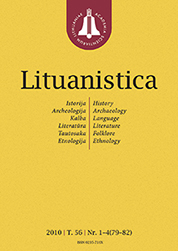LituanisticaWHAT?
 ISSN 0235-716X |
2006 m. Nr. 3 Lietuvių kalba 1863 m. sukilimo agitacijoje
The goal of the article is to define the place of folk’s – Lithuanian – language in the agitation messages. The main forms of particular agitation are discussed, original translations of the leading patriotic hymns into Lithuanian are presented.
During the years of political patriotic movement and the uprising of 1863, Lithuanian language was used both by revolutionary forces and by Russian authorities as a tool of political agitation, with the intent to win the peasants over. Agitative sermons would be preached as well as similar speeches would be held, patriotic songs would be sung in Lithuanian. Likewise Russian government used Lithuanian to proclaim the admonitions regarding the peasants’ social attitude. The written agitation messages included revolutionary proclamations and translations of Polish patriotic hymns, official decrees of the Lithuanian and Polish rebel command, as well as pronouncements of Russian authorities and papers of the Church leadership formulated under their direction. In the Lithuanian agitative texts prepared by the uprising organisers, peasants were addressed, explaining the essence of manifestation and insurrectionary benefit, providing information on religion’s persecution. Hereby peasants were encouraged to fight against the invaders for land, for freedom of Homeland and religion. Provincials were called for solidarity with Polish and landlords, and were threatened for disobedience. Some of the texts revealed political platforms of different revolutionary strata. The peasants’ attitude was influenced by the insurrectionary agitation in the native language, especially when clergy got involved into it. A similar impact was achieved also by the counterrevolutionary agitation of Russian authorities. |
Numeriai:
2011 - T.57 Nr.1, Nr.2, Nr.3, Nr.4 2010 - T.56 Nr.1-4 2009 - T.55 Nr.1-2, Nr.3-4 2008 - T.54 Nr.1, Nr.2, Nr.3, Nr.4 2007 - T.53 Nr.1, Nr.2, Nr.3, Nr.4 2006 Nr.1, Nr.2, Nr.3, Nr.4 2005 Nr.1, Nr.2, Nr.3, Nr.4 2004 Nr.1, Nr.2, Nr.3, Nr.4 2003 Nr.1, Nr.2, Nr.3, Nr.4 2002 Nr.1, Nr.2, Nr.3, Nr.4 2001 Nr.1, Nr.2, Nr.3, Nr.4 |